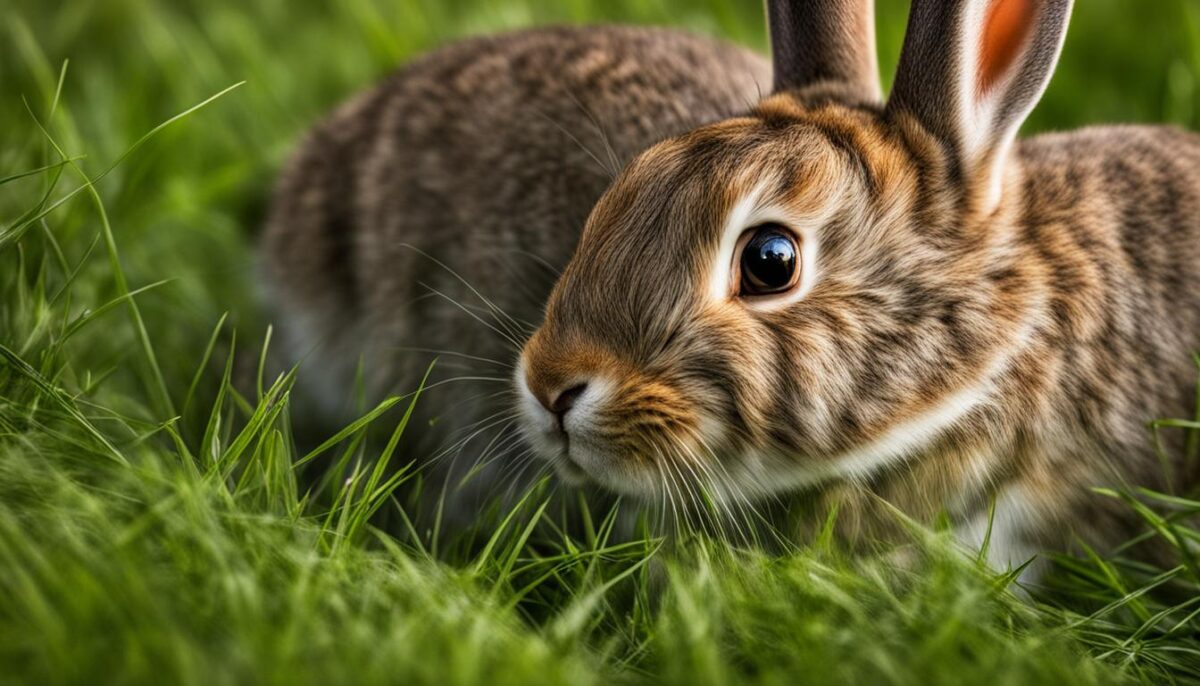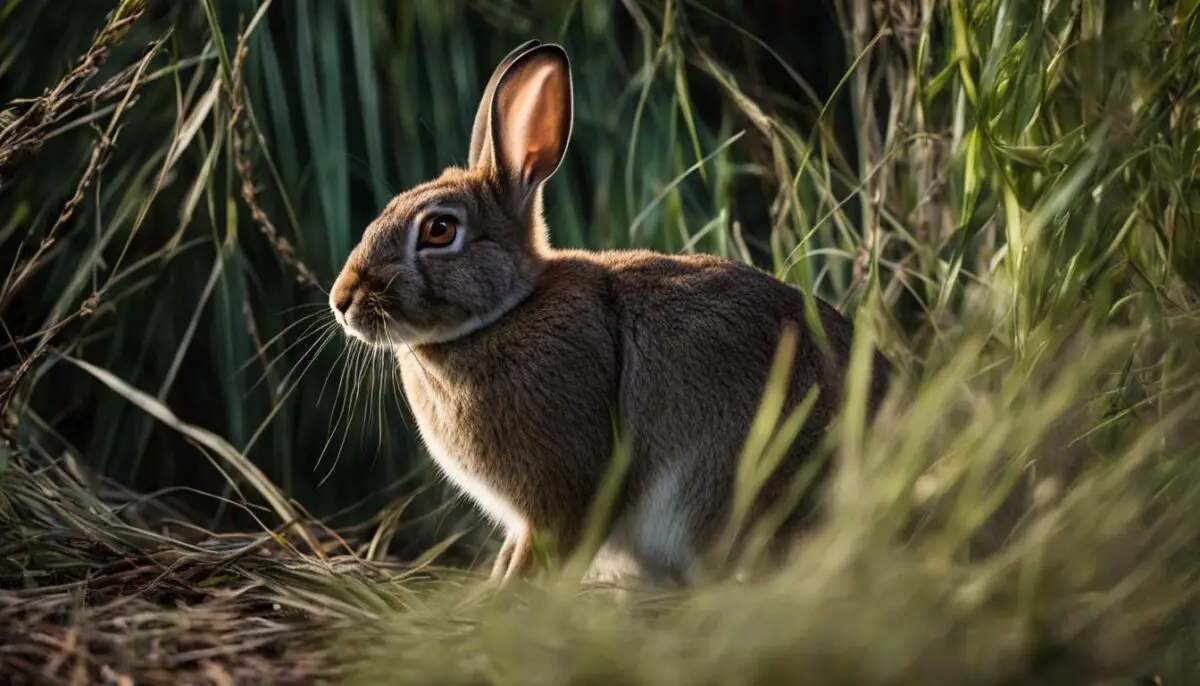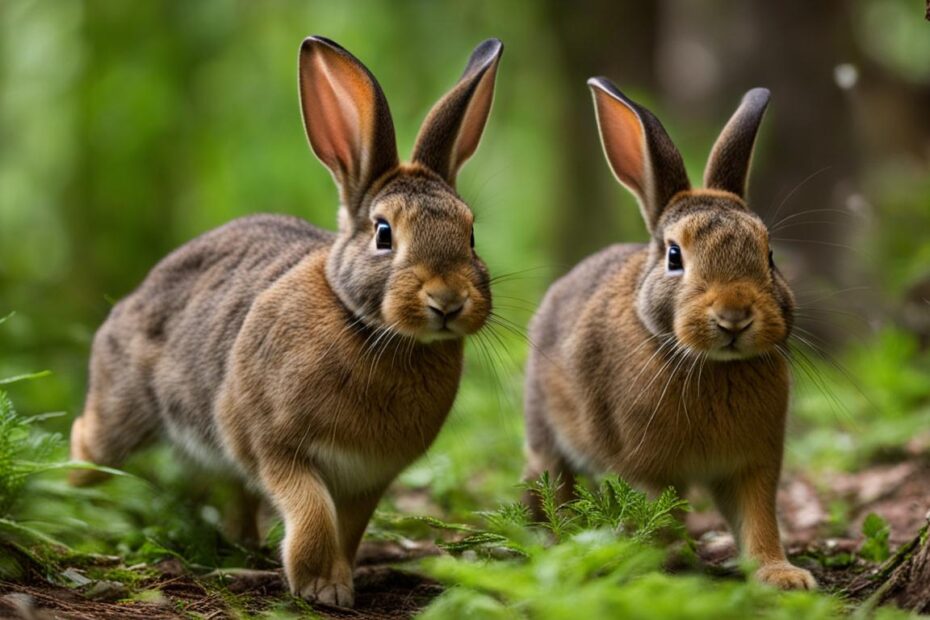Rabbits are remarkable creatures that have mastered the art of survival in the wild. Despite being prey animals, they have developed an impressive array of skills and adaptations that enable them to thrive in diverse environments. Let’s take a closer look at how rabbits survive and what sets them apart from other animals.
Key Takeaways:
- Rabbits have evolved various characteristics and behaviors that allow them to thrive in the wild.
- They possess exceptional survival skills, including predator detection, quick fleeing, and adaptation to different climates and habitats.
- Rabbits have unique physical features like a twitching nose, excellent sense of smell, temperature-regulating abilities, and strong teeth and jaws.
- Their prolific breeding habits help maintain their population even in challenging environments.
- Rabbits form social groups, communicate through various methods, and enhance their survival through collaboration and shared responsibilities.
How Rabbits Survive in the Wild
- Sprinting: Rabbits can run at a speed of up to 45 miles per hour to escape predators.
- Avoiding open spaces: Rabbits prefer to stay in areas with dense vegetation, which provides them with cover from predators.
- Performing sharp turns: Rabbits can make sharp turns while running to evade predators.
- Squeezing into small spaces: Rabbits can squeeze into small spaces to hide from predators.
- Sharp eyes: Rabbits have eyes on each side of their head, which enables them to see behind them and detect any danger from behind.
- Sensitive ears: Rabbits have long ears that can hear high-pitched mechanical and electrical sounds that humans cannot hear. They can also rotate their ears to collect sounds from predators.
- Strong hind legs: Rabbits have strong hind legs that enable them to run and jump as quickly as possible whenever necessary. They can also use their hind legs to kick predators if cornered.
- Social groups: Rabbits live in large groups known as colonies. When a rabbit detects danger, it will thump on the ground to alert other rabbits around them.
- Freeze response: Rabbits can freeze in place when they spot a predator from a distance.
The Importance of a Rabbit’s Nose in Survival
Rabbits have a remarkable sense of smell, and their noses play a vital role in their survival in the wild. The constant twitching of their noses serves a crucial purpose – it helps them detect scents in their environment, enabling them to sense danger and locate food sources. This twitching motion stimulates the scent receptors inside their nose, enhancing their olfactory capabilities. With their excellent sense of smell, rabbits can sniff out predators, locate underground food, and even regulate their body temperature.
The rabbit’s nose also contributes to temperature regulation. As they breathe, heat transfers through their nasal passages, helping to regulate their body temperature. This ability is particularly important in extreme weather conditions, as rabbits can adjust to hot or cold environments by altering their breathing rate. The twitching of their nose facilitates this process, making it an essential survival mechanism.
The Rabbit’s Remarkable Sense of Smell
“A rabbit’s sense of smell is truly extraordinary. It allows them to navigate the world around them, avoiding danger and finding the necessary resources for survival.” – Dr. Olivia Thompson, Wildlife Biologist
In addition to their twitching nose, rabbits have other adaptations that enhance their sense of smell. Their noses are highly sensitive, with thousands of scent receptors that can detect even the faintest odors. This keen sense of smell helps them locate food, identify potential mates, and detect the presence of predators. It is a crucial tool that enables rabbits to thrive in various environments and ensures their survival in the wild.
| Fact | Importance |
|---|---|
| Rabbits have an excellent sense of smell | Allows them to detect predators and locate food sources |
| The twitching motion of their nose stimulates scent receptors | Enhances their olfactory capabilities |
| Their noses aid in temperature regulation | Allows them to adapt to different environments |
Overall, the rabbit’s nose plays a vital role in their survival. It not only helps them detect danger and find food but also contributes to their ability to adapt to different climates and habitats. Without their exceptional sense of smell and the constant twitching of their nose, rabbits would face significant challenges in the wild.
The Significance of Rabbit Teeth and Jaws
Rabbits possess unique teeth and jaws that play a vital role in their survival. With 28 teeth, including incisors and cheek teeth, rabbits have the ability to efficiently slice and grind vegetation, which forms their primary diet. These ever-growing teeth allow rabbits to constantly adapt to the wear caused by their rough foliage intake, ensuring they can continue to feed effectively.
The strong jaws of rabbits serve multiple purposes. Besides enabling them to eat a wide variety of vegetation, they also act as weapons for self-defense against predators when necessary. The combination of sharp incisors and powerful jaws allows rabbits to effectively defend themselves in dangerous situations, ensuring their survival in the wild.
To summarize, the unique teeth and jaws of rabbits are perfectly adapted to their herbivorous diet and self-defense needs. Their constantly growing teeth and strong jaws allow them to efficiently consume vegetation and protect themselves from predators in their natural environment.

| Tooth Type | Function |
|---|---|
| Incisors | Efficient slicing and cutting of vegetation |
| Cheek Teeth | Grinding and crushing of vegetation |
| Ever-growing | Allows adaptation to wear caused by rough foliage diet |
| Strong jaws | Act as self-defense weapons |
The Remarkable Eyesight of Rabbits
Rabbits possess unique eyesight adaptations that contribute to their survival in the wild. Their eyes are strategically positioned on the sides of their heads, providing them with a panoramic field of vision. This wide visual range allows them to detect predators and potential threats from various angles, increasing their chances of evading danger.
A fascinating aspect of a rabbit’s eyesight is the presence of a transparent third eyelid. This specialized structure, also known as the nictitating membrane, serves multiple functions. It keeps the eyes moist and protected from dust and debris, reducing the need for frequent blinking. By maintaining clear vision, rabbits can stay alert and swiftly respond to any potential threats in their environment.
An image depicting the remarkable eyesight of rabbits.
The Wide Field of Vision
“Rabbits possess a wide field of vision, with their eyes located on the sides of their heads. This allows them to have an almost 360-degree view of their surroundings.”
Rabbits’ eyesight adaptations also include a small blind spot in front of their nose, which is the only area not covered by their field of vision. This blind spot is compensated by their acute hearing and ability to detect sounds, ensuring they remain aware of potential threats even when their vision is momentarily obstructed.
In conclusion, the remarkable eyesight of rabbits, with their wide field of vision and protective third eyelid, plays a crucial role in their survival. These adaptations enable them to detect predators, avoid danger, and remain vigilant in their natural habitats.
How Rabbits Utilize their Physical Attributes in Survival
Rabbits have several physical attributes that contribute to their survival in the wild. Their strong hind legs enable them to sprint and jump quickly to escape predators. The combination of speed and agility allows them to swiftly navigate their environment, increasing their chances of evading danger. These powerful legs are essential for their survival, as rabbits rely on their speed to outpace predators and find food.
Another important physical attribute of rabbits is their fur. The fur serves multiple purposes in their survival strategy. It provides insulation, protecting them from cold weather conditions and helping them regulate their body temperature. Additionally, the color of their fur can blend with the surroundings, providing camouflage and allowing them to hide from predators.
Rabbits’ ears are another crucial physical attribute that aids in their survival. Their long ears serve as a means of detecting sounds, allowing them to hear potential threats from a distance. The ears also play a role in dissipating heat, helping to regulate their body temperature in hot environments. This combination of hearing and thermoregulation makes the ears a vital tool for rabbits’ survival.

Table: Physical Attributes of Rabbits
| Physical Attribute | Function in Survival |
|---|---|
| Strong Hind Legs | Enable quick sprinting and jumping to escape predators |
| Fur | Provides insulation and camouflage |
| Ears | Facilitate sound detection and aid in thermoregulation |
The Role of Social Groups in Rabbit Survival
Rabbits are social animals that live in groups known as colonies. These colonies provide greater safety and survival opportunities through cooperation and shared responsibilities. Within a colony, rabbits communicate through various methods, including thumping on the ground to alert others of danger. Living in groups allows for increased predator detection and early warning, as well as enhanced group defense mechanisms.
In a rabbit colony, individuals work together to ensure the safety of the group. One of the most important roles of social groups is predator detection. With more rabbits present, there are more individuals keeping a lookout for potential threats. If one rabbit spots a predator, it can alert the others through various methods, such as vocalizations or thumping its hind legs on the ground. This early warning system allows the entire colony to react quickly and take appropriate measures to avoid danger.
Table: Advantages of Rabbit Social Groups
| Advantages | Explanation |
|---|---|
| Increased predator detection | More individuals keeping a lookout |
| Early warning system | Alerting others to potential threats |
| Enhanced group defense mechanisms | Working together to ward off predators |
Living in social groups also provides rabbits with enhanced group defense mechanisms. When a predator approaches, rabbits in the colony can band together to fend off the threat. By outnumbering the predator, they increase their chances of survival and protect vulnerable individuals, such as young or injured rabbits. Additionally, living in a group can help reduce individual vulnerability, as predators are more likely to target a single rabbit rather than an entire colony.
The Essential Survival Strategies of Rabbits
Rabbits employ several survival strategies when encountering threats in the wild. These tactics are crucial in increasing their chances of survival and are a testament to their resilience. Let’s explore some of the essential survival strategies that rabbits utilize.
The Freeze Response
When faced with a potential threat, rabbits have an instinctual freeze response. This means they stay absolutely still, blending into their surroundings to avoid detection. By remaining motionless, they reduce the chances of catching the attention of predators. This survival strategy is particularly effective when rabbits find themselves in open spaces, allowing them to remain hidden until the danger has passed.
Fleeing with Speed and Agility
If freezing isn’t a viable option, rabbits rely on their exceptional speed and agility to escape from predators. Their strong hind legs enable them to sprint at impressive speeds, reaching up to 45 miles per hour in short bursts. Coupled with their ability to make sudden, unpredictable turns, rabbits can quickly evade pursuit and find safety in nearby vegetation or burrows.
Hiding Techniques
Rabbits are adept at utilizing their environment to their advantage when it comes to hiding. They possess an innate understanding of their surroundings, allowing them to find appropriate hiding spots that provide cover from potential threats. Whether it’s burrowing into the ground or seeking refuge in dense vegetation, rabbits employ a variety of hiding techniques that help them remain undetected. This enables them to wait out dangerous situations until it is safe to emerge.
These survival tactics, including the freeze response, fleeing, and hiding, demonstrate the resourcefulness and adaptability of rabbits in the face of danger. By employing these strategies, rabbits are able to navigate the challenges of the wild and increase their chances of survival.
How Rabbits Adapt to Different Environments
Rabbits have evolved specific adaptations that allow them to thrive in various environments. These adaptations include changes in fur color, unique feet, and a specialized tail.
Fur Color
Rabbits have the remarkable ability to change the color of their fur to match their surroundings. This adaptation, known as camouflage, helps them blend into their environment and provides them with protection from predators. For example, in snowy habitats, rabbits’ fur turns white to match the snow, making it difficult for predators to spot them. Conversely, in brown or green environments, their fur color changes accordingly, allowing them to remain hidden from potential threats.
Feet
Rabbits have adapted their feet to suit different habitats. In cold regions with snowy terrain, rabbits have large feet that act as snowshoes. These large, wide feet help distribute the rabbit’s weight over a larger surface area, preventing them from sinking into the snow as they hop and allowing them to navigate the snowy landscape more effectively. On the other hand, in arid or hot habitats, rabbits have relatively smaller feet, which help them move swiftly and efficiently across the terrain.
Tail
Rabbits also possess a unique tail adaptation that aids in their survival. Their small, ball-shaped tail reduces the chances of detection by predators. Unlike long, protruding tails found in other animals, a rabbit’s short tail doesn’t catch the attention of predators, allowing them to go unnoticed while they forage for food or flee from danger.
Overall, these adaptations enable rabbits to adapt and thrive in diverse environments, making them highly adaptable and successful in their survival strategies.

Despite these challenges, wild rabbits have evolved a range of survival strategies and physical adaptations that allow them to cope with their environment. While predation, disease, and winter survival remain ongoing challenges, rabbits’ ability to adapt and utilize their innate skills plays a vital role in their continued existence in the wild.
Conclusion
Rabbits possess a remarkable set of survival skills and adaptations that allow them to flourish in a variety of environments. Through their twitching nose, heightened senses, and strong teeth, these wild creatures navigate the challenges they encounter in the natural world. By forming social groups, employing strategic survival tactics, and adapting physically to different climates and habitats, rabbits have developed effective strategies to overcome adversity.
While wild rabbits must face numerous predators and contend with diseases and habitat loss, their population remains resilient due to their prolific breeding habits. This enables them to sustain their numbers even in the most challenging circumstances. Despite the difficulties they encounter, rabbits are equipped with the necessary tools to not only survive but thrive in their natural habitats.
As we delve deeper into understanding the survival skills and adaptations of rabbits, we gain a greater appreciation for these remarkable creatures. Their ability to adapt and persevere in different environments highlights the resilience and resourcefulness of the wild rabbit population. By continuing to study and appreciate their unique characteristics, we can contribute to the conservation and protection of these wonderful creatures for generations to come.
FAQ
How do rabbits survive in the wild?
Rabbits have evolved various survival skills and adaptations such as detecting predators, quickly fleeing to safety, adapting to different climates, and having unique physical features.
What is the importance of a rabbit’s nose in survival?
A rabbit’s nose plays a crucial role in survival as it helps them detect scents in their environment, improving their ability to sense danger and locate food sources.
What is the significance of rabbit teeth and jaws?
Rabbit teeth and jaws are vital for survival as their teeth are ever-growing, allowing them to constantly adapt to their rough foliage diet, and their strong jaws enable them to eat vegetation and serve as self-defense weapons.
How remarkable is the eyesight of rabbits?
Rabbits have eyes located on the sides of their heads, providing them with a panoramic field of vision, and they also have a transparent third eyelid that keeps their eyes moist and protected.
How do rabbits utilize their physical attributes in survival?
Rabbits use their strong hind legs to sprint and jump quickly to escape predators, their fur provides insulation and camouflage, and their long ears aid in detecting sounds and dissipating heat.
What is the role of social groups in rabbit survival?
Living in colonies provides greater safety and survival opportunities through cooperation, shared responsibilities, predator detection, and group defense mechanisms.
What are the essential survival strategies of rabbits?
Rabbits employ strategies such as the freeze response, fleeing, and hiding to evade predators and increase their chances of survival.
How do rabbits adapt to different environments?
Rabbits adapt to different environments through their fur color changing to match their surroundings, having large feet for navigating snowy terrain, and possessing a small, ball-shaped tail to reduce the risk of predation.
What challenges and limitations do wild rabbits face?
Wild rabbits face challenges such as predators, disease, habitat loss, and harsh weather conditions, with winter survival being particularly challenging due to scarce food sources.
What are the key survival skills and adaptations of rabbits?
Rabbits have a range of survival skills and adaptations including their senses, teeth, agility, camouflage, social behavior, and ability to adapt to different environments, allowing them to thrive in the wild.


